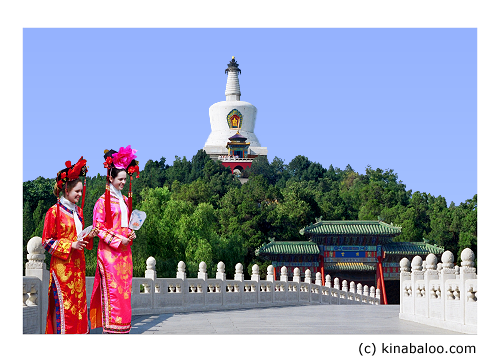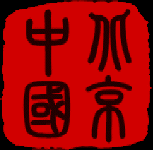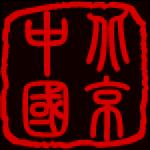| 
Introduction to Beihai Park  Beihai Park, in central Beijing close to the Forbidden City, is one of the most carefully preserved imperial gardens in China. The park has its origin in the Liao dynasty (907 - 1125), although what we see today dates mostly from the Qing dynasty (1644 - 1911). In particular, with the reign of emperor QianLong (1736 - 1795) who commissioned a number of the landmarks in the park. However, the White Dagoba was constructed earlier, in 1651. BeiHai Park covers a total area of over 68 hectares, of which about one half is a beautiful lake. With many places of interest, the park is a favorite place to relax or explore - for both locals and tourists alike. BeiHai Park is an excellent living example of the ancient Chinese art of landscaped gardens, with artificial hills, pavilions, halls, temples and covered corridors blended with trees, hills and a lake in a harmony of man and nature. Indeed, it is like a mini Summer Palace in the heart of Beijing. In this guide to BeiHai Park, we will take a tour of all the main sites, accompanied by many beautiful photographs. We also discuss the history of the park and present a useful map.
History of BeiHai Park
Liao and Jin Dynasties  Early in the 10th century, the Liao dynasty created a secondary imperial palace at the site of the present Beihai Park. The lake was added during the Jin Dynasty. The earth removed to construct the lake was used to create three islands. Two have become joined to nearby land over time but the main one remains in the present park. Yuan Dynasty In the 13th century the Mongols conquered the Jin and established the Yuan Dynasty (1279-1368). The first Yuan emperor, Kublai Khan, expanded the site and made it the center of DaDu ('Great Capital'), the Yuan capital city (what is now Beijing). Kublai Khan lived in what is now referred to as the 'Round City'. Ming Dynasty  When the city of Beijing was laid out in its current plan (1406 - 1420 AD) during the reign of Ming Emperor YongLe, Beihai Park was restructured. It continued to function as the imperial family's pleasure garden. The lake was expanded and turned into the centerpiece of this magnificient and classical example of a chinese garden. However, the primary imperial palace - here under the Yuan Dynasty - was from then on to be the newly created Forbidden City. Qing Dynasty  Most of the buildings now standing were constructed during Emperor QianLong's reign (1736-1796) during the Qing Dynasty (1644 - 1911). It was Emperor QianLong who added the Five Dragon Pavilions and the Nine Dragon Screen. In 1651, the White Dagoba, a Buddhist tower in Tibetan style (and the famous landmark of both Beihai Park and Beijing), was erected at the suggestion of a famous Tibetan Lama priest by the name of NaomuHan. Qing Emperor Shun Zhi agreed to this project as a gesture of devotion to the Buddhist faith - and from a desire for unity among China's various nationalities. It stands on top of the hill on Jade Island (JiongHua).
Beihai Park Today  BeiHai Park was first opened to the public in 1925 and in 1961 it was one of the first important cultural sites to be placed under state protection. BeiHai Park is a popular retreat for many local citizens. It is a place to cool down and relax in summer, and in winter it becomes one of the biggest skating rinks in the city. There are a great many places to explore within the park, especially along the east and north sides - pavilions, temples, ponds and much more. The gardens of BeiHai Park are partly modelled on the style of gardens in south China, so, fittingly, south China style paper umbrellas are on sale for protection from the heat of the sun in summer. There are a variety of restaurants and cafes to take a break. BeiHai Park is open daily from 6:00 - 21:00. Admission is 10 yuan (20 yuan during holidays).
Videos of Beihai Park [kvideo v=UHInaCD1ueM w=640] [kvideo v=kQG1WfQ_9nE w=640] [kvideo v=Ej5k0sVXSlI w=640] | 










 Layout and map of Beihai Park
Layout and map of Beihai Park Next : History of Beihai Park
Next : History of Beihai Park